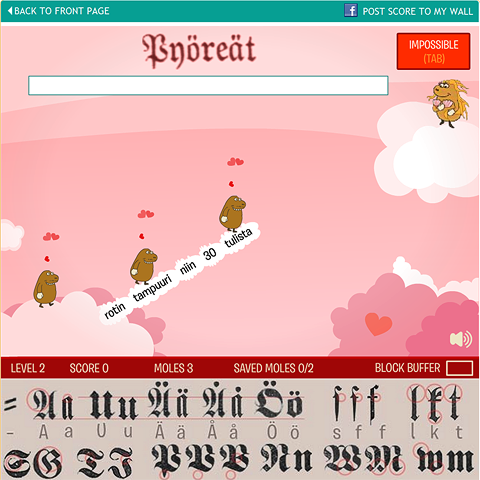Gamification of mundane tasks is set to become as important as usability and learnability online

There has been a significant amount in the press recently about Finnish National Library microsite - ’Digitalkoot’ which has managed to combine the best elements of gamification and crowdsourcing to get members of the public to willingly participate in menial data entry.
Hundreds of thousands of documents have been scanned into the national library archives, but a lot of the printed material is too fuzzy for automatic text recognition to work. This is where games ’Mole Bridge’ and ’Mole Hunt’ come in - the first game involves deciphering individual words against the clock, each word becomes a segment of a bridge which helps the moles get to safety; if you are too slow or enter a wrong word, then one or more moles will plummet to their death! The second game ’Mole Hunt’ is more of a verification style game, where you simply approve or reject the suggested transcripts.
Both games are actually easy and tricky at the same time. You need to be very quick for ’Mole Bridge’ and the words are often very hard to decipher and quite long really - also, you really need a Finnish keyboard for the special characters! The system cleverly verifies the words through mass public opinion, and then slots them back in their correct order in the many reference documents they were originally pulled from, quite genius really!
In any case, this social experiment has been brilliantly successful at getting members of the public to do free work in return for just a little recognition via a leaderboard mechanic - where results can also be posted to the major social networking sites.
When I graduated from university and was deciding exactly what to do, I took on a number of tedious office admin jobs - ’Data Entry!’ - which would have benefitted enormously from having some kind of gaming element to make those tasks more enjoyable. The more enjoyable a repetitive task is, the less likely one is to loose focus / interest and therefore start making mistakes. The thing about mundane repetitive tasks is that they are a spiral of ever decreasing results as interest and concentration quickly wanes. The gaming mechanic helps sustain interest and focus, and makes it more enjoyable to participate in mundane repetitive tasks.
With several tasks on the internet, you can make them as usable and learnable as you like, but if they are not fun, many people won’t get involved, and certainly won’t like to repeat the process. We are familiar with a number of gaming mechanics on the Internet at large - more obvious check-in functions in Facebook and entire sites like Foursquare and Gowalla, as well as various badging systems, like Affino’s Automated Customer Ladder.
Using ’Fun’ and Abraham Maslow’s ’Hierarchy of Needs’ as the cornerstones of your application framework, you can use entertainment and recognition to encourage users / customer to engage in tasks they might not normally be willing to indulge in. Gamification will encourage more people to get involved more often - for system developers, this is surely a winning a scenario.
We already have a number of gaming elements built into our Affino platform, and are fortunate to be in the process of significantly re-working the platform for the next major version release - ’Affino 7’. We will be introducing all manner of gaming elements which don’t get in the way of tasks and processes, but make the day to day experience of using Affino - simply more enjoyable and more rewarding. For certain we will be expanding the scope of the customer ladder, and adding some ’Mole Bridge’ -type gloss to a number of the more mundane tasks - which should be good news for all concerned...

Did you find this content useful?
Thank you for your input
Thank you for your feedback
Upcoming and Former Events
Affino Innovation Briefing 2024
Webinar - Introduction to Affino's Expert AI Solutions - Session #2
Webinar - Introduction to Affino's Expert AI Solutions - Session #1
PPA Independent Publisher Conference and Awards 2023
Meetings:
Google Meet and Zoom
Venue:
Soho House, Soho Works +
Registered Office:
55 Bathurst Mews
London, UK
W2 2SB
© Affino 2024
















